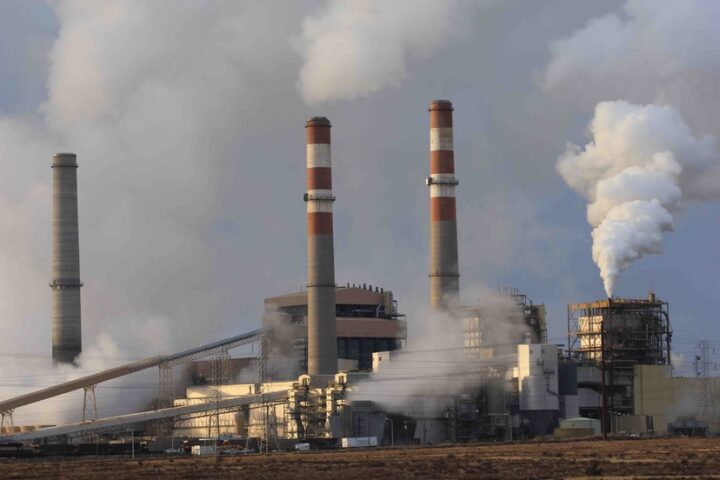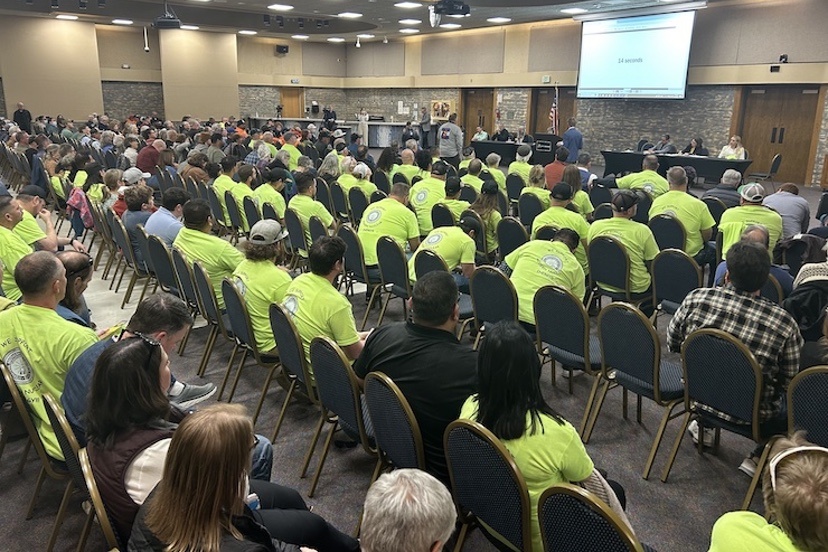Photo: Crowd at a recent meeting in Pueblo (by Allen Best.)
It may surprise many residents in Aspen and Vail and their respective valleys that they own a piece of a coal plant.
Literally.
Customers of Holy Cross Energy also own the electrical cooperative. Holy Cross, in turn, owns 8% of Comanche 3, the coal plant in Pueblo that is to close by 2031. Holy Cross pays property taxes for the plant but consigns its share of the output to a third party.
What obligations do Holy Cross — or the rest of Coloradans, for that matter — have to leave Pueblo economically whole in this energy transition? When Colorado legislators adopted decarbonization goals in 2019, they also created the Office of Just Transition.
Coal workers and communities, they said, needed assistance in this energy transition.
Still unclear is what exactly ‘just transition’ means. It does involve money, though.
Comanche 3 and two older coal-units, one of which is already closed, have delivered 16% of the property taxes for schools, firefighters and other governmental services in Pueblo County. Closing all three units reduces Colorado’s greenhouse gas emissions 21%.
Nuclear power could replace Comanche 3’s lost generation and actually add jobs and tax base. Xcel Energy, which owns two-thirds of Comanche 3, has paid Pueblo County and its various library, fire and other jurisdictions about $25 million a year in property taxes. Holy Cross pays $1.3 million and CORE Electrical Cooperative, the third owner, $4.6 million. The total, in 2021, was $31 million.

An advanced nuclear plant would deliver $95 million in property taxes, according to a task force appointed by Xcel Energy, plus 300 jobs, compared to the 77 that will be lost when Comanche 3 closes, and at wages of up to $200,000 a year.
The task force, relying primarily upon experts supplied by Xcel, concluded that a new natural gas plant combined with carbon capture and sequestration was the next best but much inferior option.
As for solar, Pueblo County already has oodles of it — and more will come. But the task force correctly noted the economic benefits of solar to Pueblo can never replace those of a big coal-fired power plant. Hydrogen and various energy storage technologies also come up short.
Xcel itself has not said what it wants to do. The company must submit what is called a ‘Just Transition’ electric resource plan to state regulators by June 1. The plan is supposed to identify what new electric generation could be cost-effectively placed in Pueblo County.
The task force report warns against ‘just transition’ being an “empty slogan.” Fair enough. But does ‘just transition’ mean disregarding cost and safety considerations?
Nuclear has a reputation for costly overruns. Recent experiences in the United States have not helped. Two reactors in Georgia came in at $35 billion, double original estimates. In Idaho, the plug was pulled recently on another plant with a rising price tag. China is building lots of nuclear reactors, owing partly to lower labor costs and fewer regulations.
Pueblo lacks consensus about its future. That was clear during a recent town hall in Pueblo attended by more than 600 people. Included were about 100 people wearing yellow-green T-shirts that identified the wearers as members of the International Brotherhood of Electrical Workers — and supporters of nuclear energy!
Opponents included speakers who objected to storing radioactive wastes in Pueblo. One warned of impaired property values within 10 miles of the plant, including all of Pueblo.
Cost is the idea’s greatest vulnerability. An individual who reported 44 years experience in nuclear, first in submarines and then a nuclear power plant, waved away safety concerns. Cost, though, was a problem.
Cost was also cited by a visitor from Boulder. She confidently predicted that state regulators charged with looking after the interests of Xcel customers would reject the idea. Pueblo itself is served by another utility, Black Hills Energy. Her observation was not welcomed and her conclusion rejected by some because of where she’s from. But Xcel also delivers electricity to Alamosa and Sterling, Breckenridge and Rifle, Greeley and Grand Junction. Cost matters in all those places.
Which leaves us with the question of what will Xcel propose in June? Informed speculation suggests another natural gas plant. The technology is proven. The carbon capture component still needs work, though.
Xcel has agreed to pay $15.9 million annually in property taxes on the idled coal plant through 2040, a decade after it closes. (Holy Cross has not been asked, a spokeswoman said).
What could work for Pueblo and its workers? I suspect it may somehow lie in Front Range passenger rail and continued investment by Pueblo in its own community amenities. It has water and it has land.
Nuclear energy may eventually solve its cost and waste problems. It has not yet.
Allen Best publishes the e-journal Big Pivots, which chronicles the energy transition in Colorado and beyond.

